San Francisco’s Potrero Yard Modernization Project will replace an obsolete, century-old bus yard with a modern four-story bus maintenance and storage facility with integrated housing and retail. This ground-breaking approach is a first-of-its-kind joint development of a bus maintenance facility with housing and commercial spaces in North America and prioritizes a safe, equitable, and sustainable transportation system while also supporting the city’s housing goals.
Muni is the 8th largest transit agency in a major American city, and this is the flagship project for our $2+ billion Building Progress Program to modernize and electrify Muni’s aging bus yards. Rebuilding the Potrero Yard is a transformational project that will have a ripple effect on the SFMTA’s ability to support a system-wide zero emission vehicle fleet.
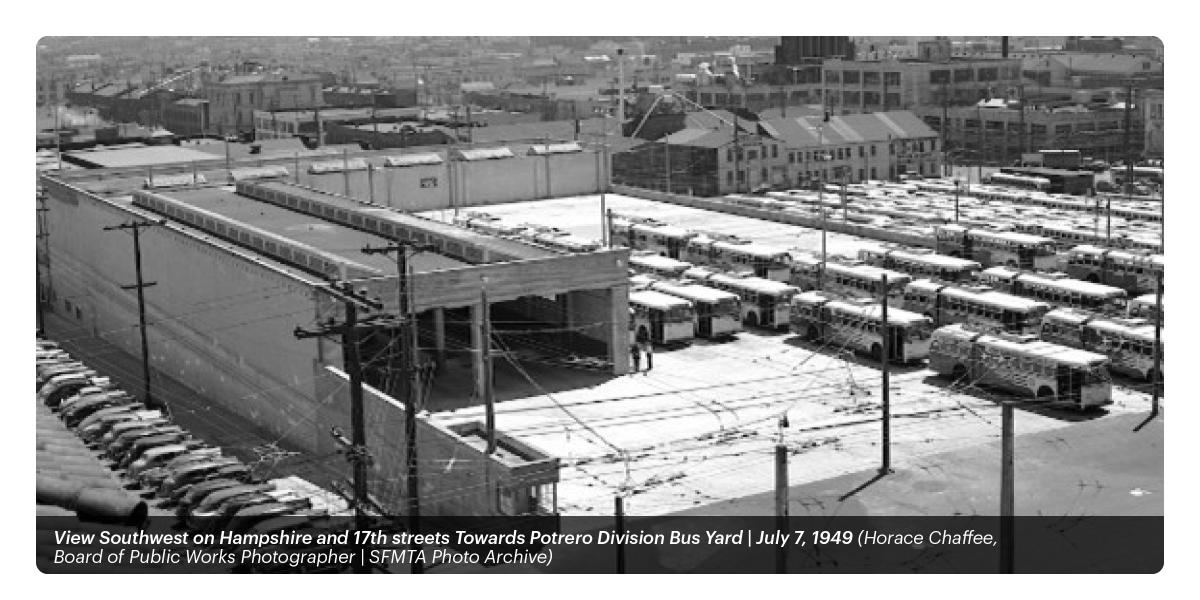
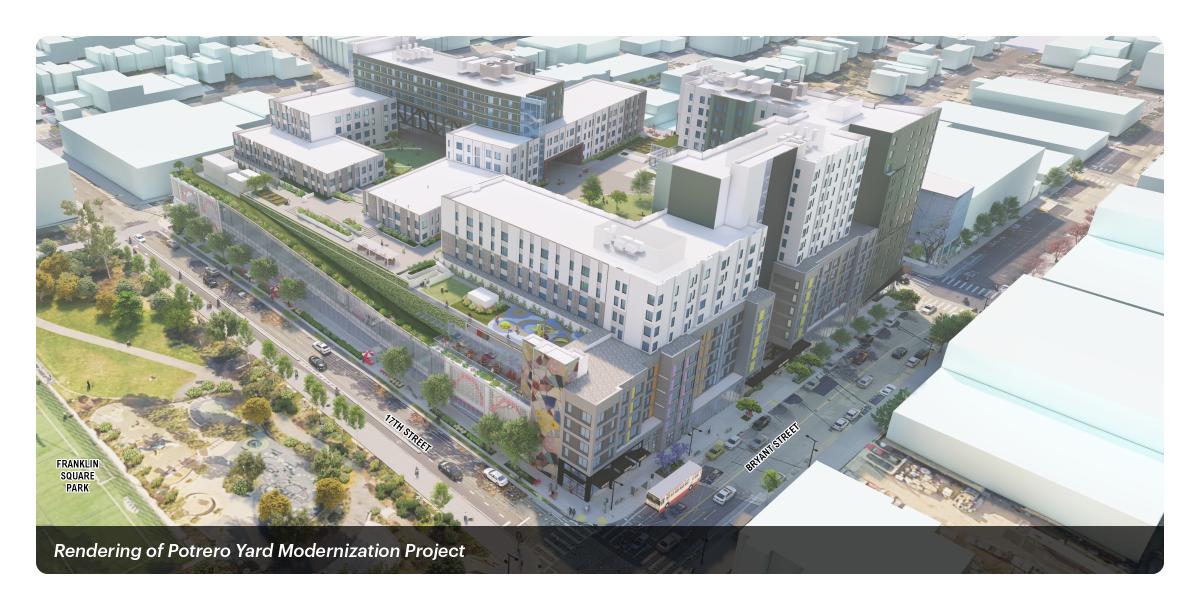
Needs
The redevelopment of Potrero Yard into a modern, safe, and efficient bus maintenance facility is a critical investment into both the city’s and USDOT’s shared priorities:
- Reduced Emissions: Completely rebuilding the Potrero Yard will make it the central hub for the SFMTA’s zero emission trolley bus fleet. It will house an additional 92 trolley buses (and 80% increase from the current design capacity) allowing the city to take a major step towards operating an all-electric fleet by 2040.
- Equitable Transit for Enhanced Mobility: Five of San Francisco’s nine Muni Service Equity neighborhoods are served by Potrero Yard buses. These communities have high percentages of households with low incomes and people of color with the fewest transportation options available. A modern Potrero Yard will allow SFMTA maintenance staff to efficiently get buses back into service for those that rely on Muni service the most.
- Innovation and Efficiency: Yard staff are challenged by an outdated facility with space and equipment constraints slowing down bus maintenance and repairs and delaying getting buses back into service. For example, maintenance bay ceilings are too low to repair equipment on bus roofs or lift buses to repair them from below. Updating Potrero Yard to meet modern maintenance standards will allow staff to deliver improved transit reliability efficiently and safely and get buses back into service sooner.

- Ability to Accommodate Future Growth: San Francisco is projected to grow 34% in jobs and 58% in homes between 2015 and 2050. This project is needed to store and maintain 80% more electric trolley buses to support this population growth.
- Infrastructure Resiliency and Emergency Preparedness: Built in 1915, Potrero Yard does not meet modern seismic standards. Bringing the yard to 21st century design and safety standards will support the city’s ability to continue providing transit service in an emergency or natural disaster.
- Innovative Solutions to Complex Transit Needs through Joint Development: Developable land is scarce in San Francisco, contributing to the high cost of car ownership, limited housing options, and restricted small business growth. The use of agency-owned land to invest in needed clean energy transit is also an opportunity to build affordable housing and community-based retail businesses through a joint development.
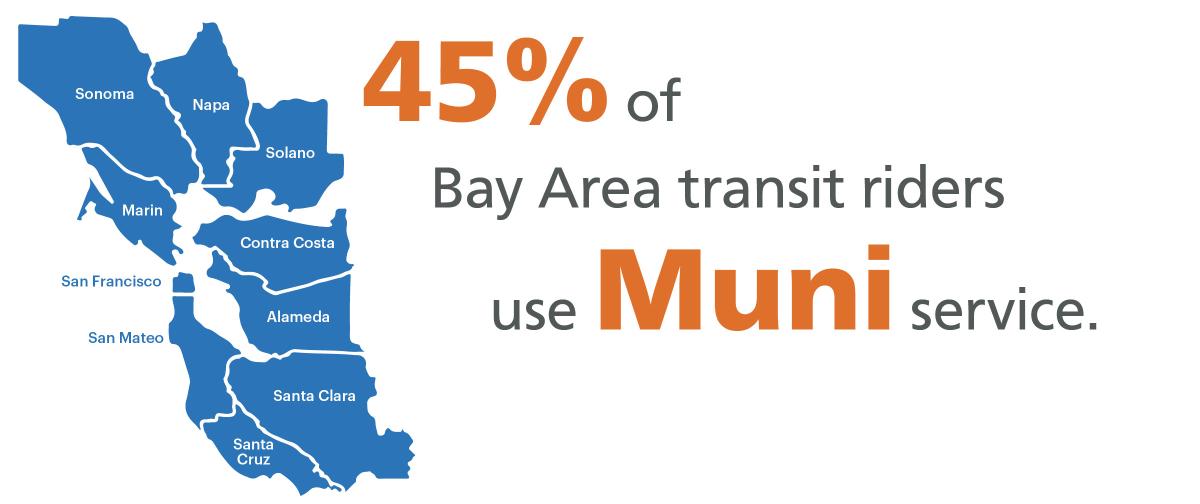
A Modern Bus Yard for a Transit-First City
With the adoption of its transit-first city policy in 1973, San Francisco has continued to prioritize a more equitable transportation system that relies on public transit and other forms of active transportation such as walking, biking, and micro-mobility.

The modern bus maintenance facility will expand transit capacity by demolishing the existing yard and constructing a new 700,000 gross square feet facility that can accommodate 250 buses and 830 employees.
The project is shovel ready and has secured all the necessary entitlements. Grant funds could be used within 12 months, allowing the FTA to see its funds put to immediate use. The project is scheduled to break ground in 2025 with substantial completion in 2028.

The total bus facility project cost is approximately $515 million. The SFMTA will be providing $400 million in local funds for the project and is requesting $115 million from the FTA. To date, the SFMTA has identified $52.6 million in local matching funds and additional local funding is planned to come from future General Obligation Bond proceeds pending voter approval by November 2026.
This Project is funded through a public private partnership (P3) with Potrero Neighborhood Collective (PNC), the city’s selected project developer, in which PNC will invest its own capital and raise any additional financing necessary to design and develop the property. P3s allow the costs of investment to be spread over the lifetime of the asset to reduce the life-cycle costs of the Project.
Zero Emission Fleet
California is a leader in the transition to green energy with regulations for public transit agencies to achieve zero-emission fleets by 2040. The Potrero Yard Modernization Project is a critical step in supporting the SFMTA's Zero-Emission Bus Rollout Plan and transforming Muni facilities to support a system-wide zero emission vehicle fleet.

The new Potrero Yard facility will support transitioning to a zero-emissions fleet with an 80 percent increase in electric trolley buses at the yard that generate no direct or indirect particulate emissions since they are powered by the Hetch Hetchy hydroelectric dam. This ecosystem of clean energy will provide emissions-free transit service to about 111,000 riders each day – more than a fifth of Muni’s total ridership.
Sustainability
The Potrero Yard is a multi-faceted approach to greenhouse gas reduction. In addition to housing a zero-emission vehicle fleet, the building will also be all-electric, use the cleanest engines available during construction, and have a minimum LEED v4 Gold certification.
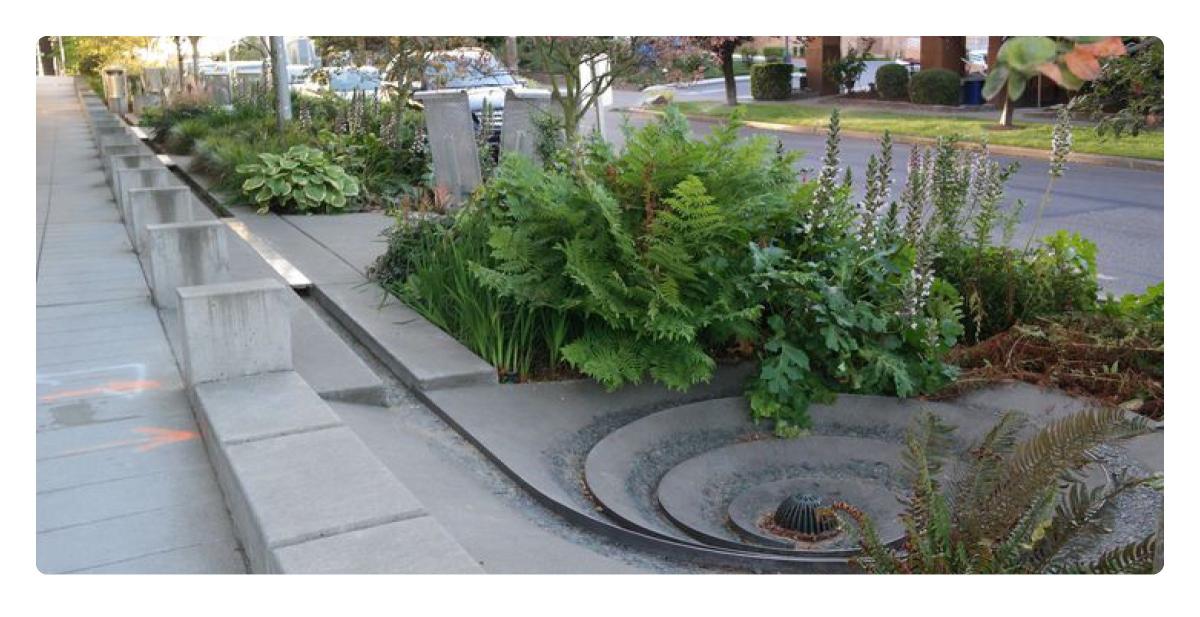
Water reuse: In addition to greenhouse gas reduction measures, the Project will also include a number of water conservation elements such as flow-through planters, bioswales, an stormwater storage tanks to meet anticipate non-potable water demands.
The Housing and Commercial Component of the project provides affordable housing close to transit services, allowing travel by low-cost emissions-free transit while reducing vehicles miles traveled from personal vehicles.
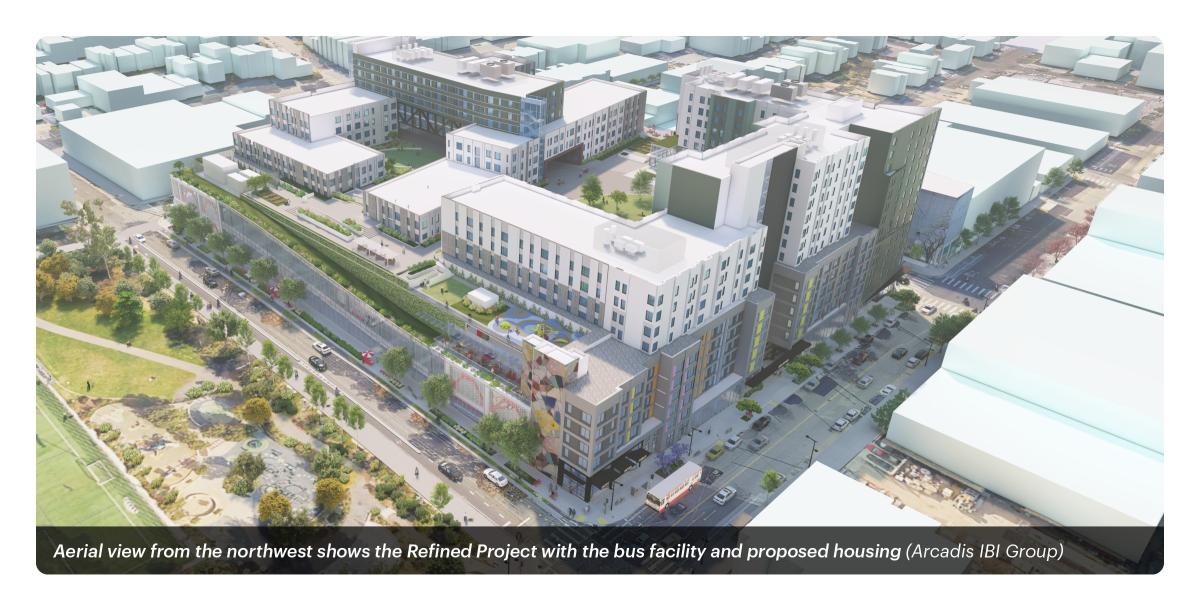
Refined Project: The housing component will include up to 465 units of affordable housing (household income 30% – 80% of area median income) and workforce housing (household income 80% – 120% area median income).
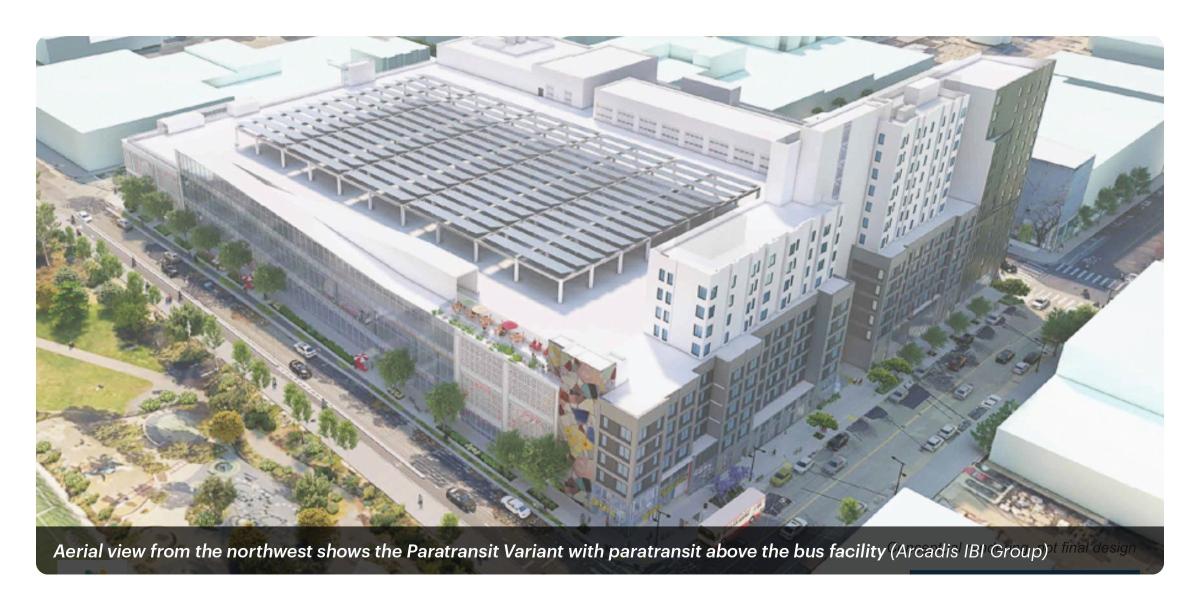
Project Variant: With the current paratransit fleet located outside of San Francisco, the Paratransit project alternative would house the fleet at an SFMTA yard, supporting the city’s sustainability goals by reducing vehicle miles traveled, time spent in non-revenue service, and increased solar photovoltaic systems on the roof. This Project alternative would include up to 104 units of affordable housing.
The Project will also include three new retail spaces, onsite childcare, and laundry facilities to reduce resident need for personal vehicles.
Good-paying Clean Energy Jobs
The SFMTA maintains a skilled and trained workforce that includes 17 unions representing approximately 6,000 employees. For this project, the SFMTA will expand its registered maintenance machinist apprenticeship in partnership with Advanced Manufacturing and Transportation Apprenticeship of California and Automotive Machinists Union Local 1414. We will also create a four-year workforce training and development program designed to re-train existing workers in the operation, servicing, repair, and maintenance of all electric vehicle infrastructure and fleet, including battery electric buses.
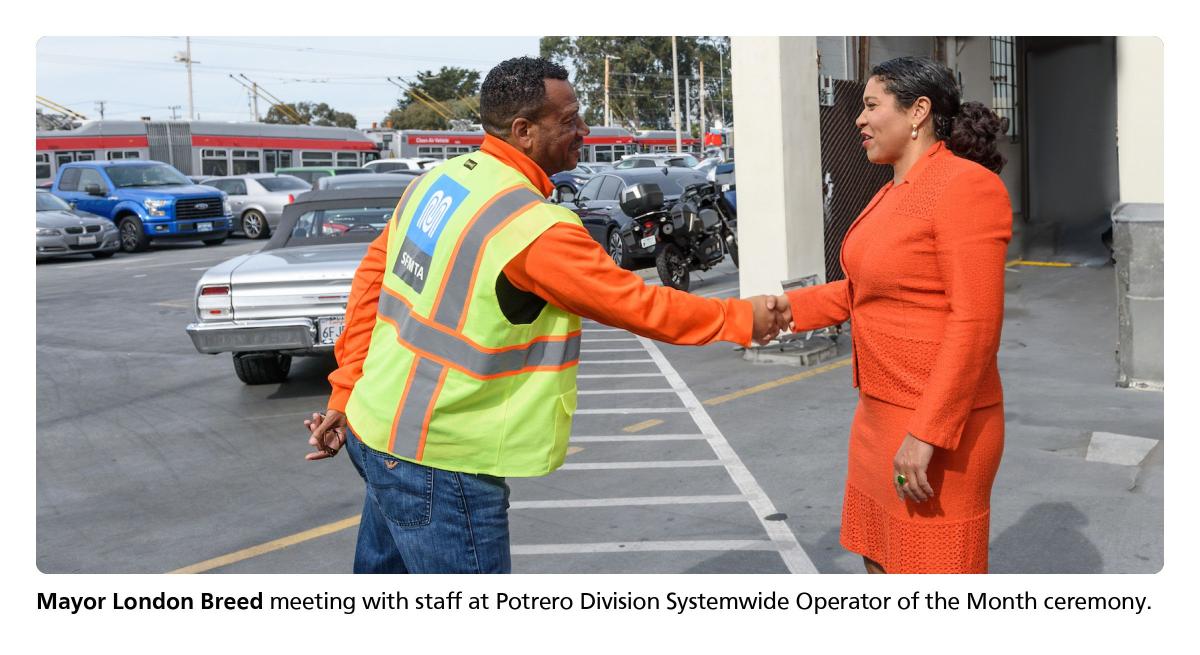
To support workers in training and for up to one-year post-hire, the SFMTA will coordinate with unions, trainers, and peer Community Based Organizations to provide wrap-around services for workers in need such as direct financial assistance.
Justice40 - Benefitting those most in need
The Potrero Yard provides bus service for six routes – all of which serve Muni Service Equity neighborhoods. These routes provide transit service to 29 overburdened and underserved census tracts identified in the CJEST, and the new bus yard will better serve these communities by providing more reliable transit service.
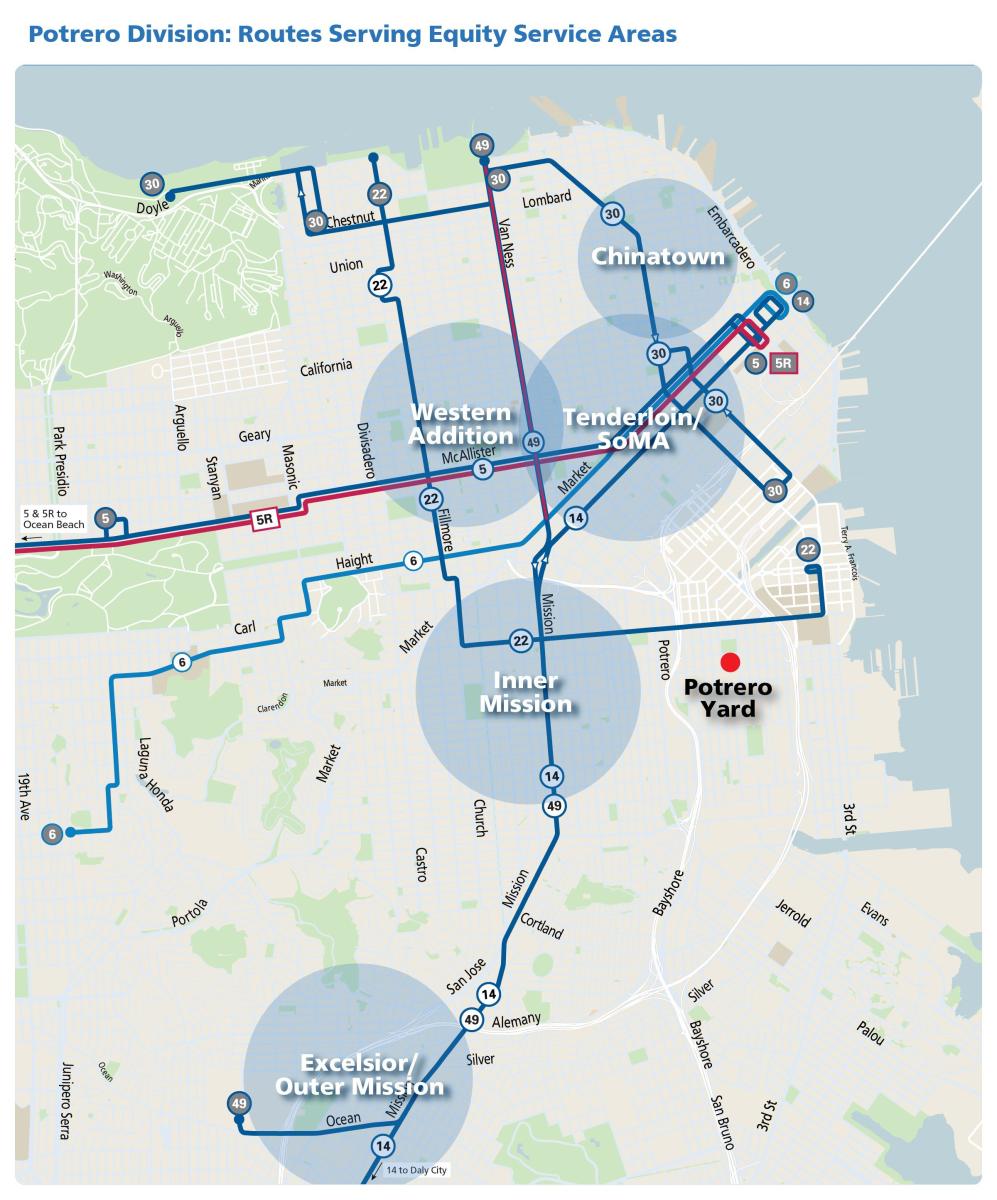
This project will allow for quicker repairs to buses and improve transit reliability on routes that serve Equity Neighborhoods with concentrations of low-income households, affordable or public housing developments, residents of a minority group, and those with low levels of car ownership. These San Franciscans have the fewest transportation options available and rely on Muni.
In addition, the project site is located adjacent to a disadvantaged neighborhood in Potrero Hill, providing much needed affordable housing close to transit service and improved infrastructure for pedestrian and bicyclist safety. The Housing and Commercial Component of the Project will meet San Francisco’s need for more housing and support the city’s goal of constructing 82,000 new units by the year 2031.
Outreach
We believe that community should help to shape many of the decisions that are needed to rebuild the Potrero Yard and have actively engaged the public by:
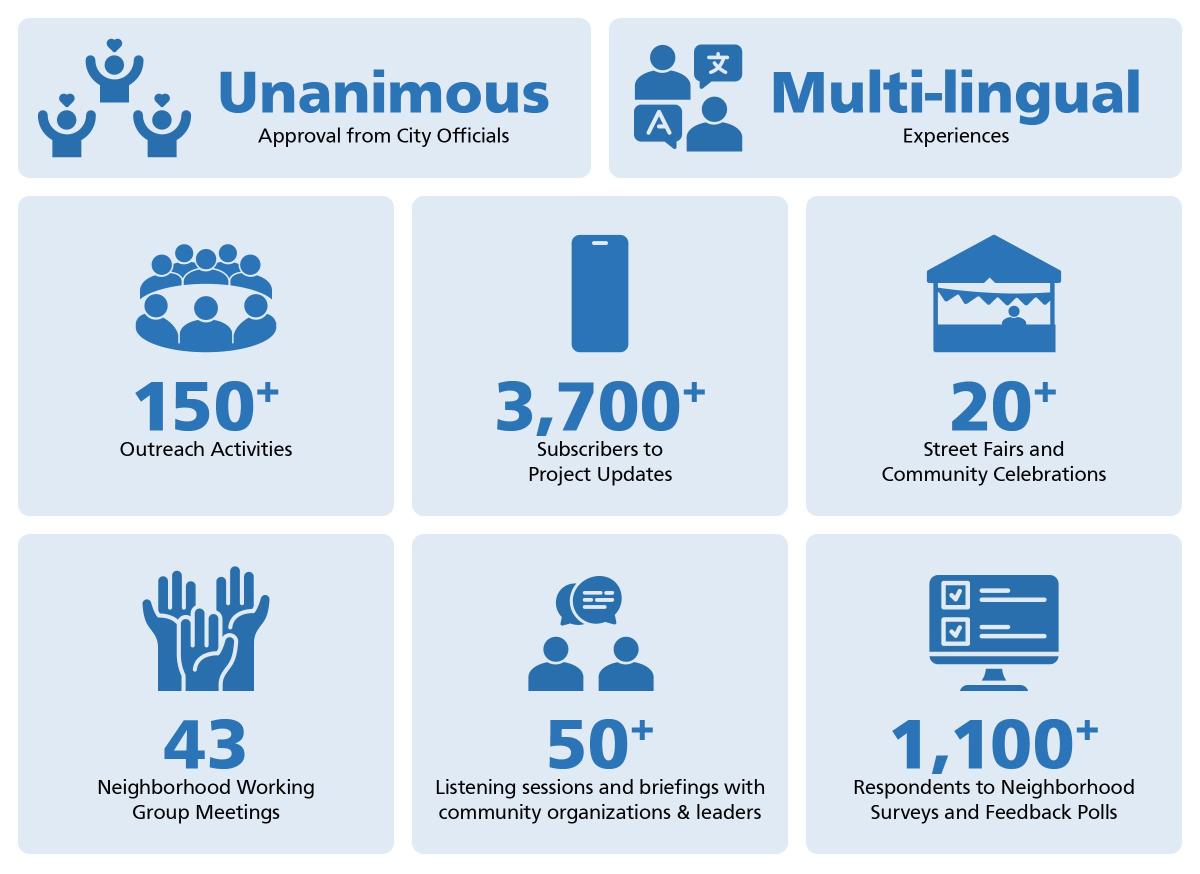
Community input has shaped the project. Based on community feedback, the project design includes novel elements including:
- ground floor public restroom
- community-accessible meeting space
- public art that reflects the diversity of Potrero Hill and Mission District neighborhoods as well as Muni’s longstanding commitment to safe, equitable, transit service
About the Developer
Potrero Neighborhood Collective, LLC (PNC) is the SFMTA's selected lead developer for the Project. PNC is a unique combination of firms who bring global leadership in infrastructure development with local expertise rooted in San Francisco.

|
Infrastructure Developer and Workforce Housing Developer |
||||||||||||||||||||||||||||||||||||||||||||||||||||||||||||||||||||||||||||||||||||||||||||||||||||||||||||||||||||||||||||||||||||||||||||||||||||||||||||||||||||||||||||||||||||||||||||||||||||||||||||||||||||||||||||||||||||||||||||||||||||||||||||||||||||||||||||||||||||||||||||||||||||||||||||||||||||||||||||||||||||||||||||||||||||||||||||||||||||||||||||||||||||||||||||||||||||||||||||||||||||||||||||||||||||||||||||||||||||||||||||||||||||||||||||||||||||||||||||||||||||||||||||||||||||||||||||||||||||||||||||||||||||||||||||||||||||||||||||||||||||||||||||||||||||||||||||||||||||||||||||||||||||||||||||||||||||||||||||||||||||||||||||||||||||||||||||||||||||||||||||||||||||||||||||||||||||||||||||||||||||||||||||||||||||||||||||||||||||||||||||||||||||||||||||||||||||||||||||||||||||||||||||||||||||||||||||||||||||||||||||||||||||||||||||||||||||||||||||||||||||||||||||||||||||||||||||||||||||||||||||||||||||||||||||||||||||||||||||||||||||||||||||||||||||||||||||||||||||||


|
Affordable Housing Developers | ||||||||||||||||||||||||||||||||||||||||||||||||||||||||||||||||||||||||||||||||||||||||||||||||||||||||||||||||||||||||||||||||||||||||||||||||||||||||||||||||||||||||||||||||||||||||||||||||||||||||||||||||||||||||||||||||||||||||||||||||||||||||||||||||||||||||||||||||||||||||||||||||||||||||||||||||||||||||||||||||||||||||||||||||||||||||||||||||||||||||||||||||||||||||||||||||||||||||||||||||||||||||||||||||||||||||||||||||||||||||||||||||||||||||||||||||||||||||||||||||||||||||||||||||||||||||||||||||||||||||||||||||||||||||||||||||||||||||||||||||||||||||||||||||||||||||||||||||||||||||||||||||||||||||||||||||||||||||||||||||||||||||||||||||||||||||||||||||||||||||||||||||||||||||||||||||||||||||||||||||||||||||||||||||||||||||||||||||||||||||||||||||||||||||||||||||||||||||||||||||||||||||||||||||||||||||||||||||||||||||||||||||||||||||||||||||||||||||||||||||||||||||||||||||||||||||||||||||||||||||||||||||||||||||||||||||||||||||||||||||||||||||||||||||||||||||||||||||||||||
|


|
Design Team | ||||||||||||||||||||||||||||||||||||||||||||||||||||||||||||||||||||||||||||||||||||||||||||||||||||||||||||||||||||||||||||||||||||||||||||||||||||||||||||||||||||||||||||||||||||||||||||||||||||||||||||||||||||||||||||||||||||||||||||||||||||||||||||||||||||||||||||||||||||||||||||||||||||||||||||||||||||||||||||||||||||||||||||||||||||||||||||||||||||||||||||||||||||||||||||||||||||||||||||||||||||||||||||||||||||||||||||||||||||||||||||||||||||||||||||||||||||||||||||||||||||||||||||||||||||||||||||||||||||||||||||||||||||||||||||||||||||||||||||||||||||||||||||||||||||||||||||||||||||||||||||||||||||||||||||||||||||||||||||||||||||||||||||||||||||||||||||||||||||||||||||||||||||||||||||||||||||||||||||||||||||||||||||||||||||||||||||||||||||||||||||||||||||||||||||||||||||||||||||||||||||||||||||||||||||||||||||||||||||||||||||||||||||||||||||||||||||||||||||||||||||||||||||||||||||||||||||||||||||||||||||||||||||||||||||||||||||||||||||||||||||||||||||||||||||||||||||||||||||||
|

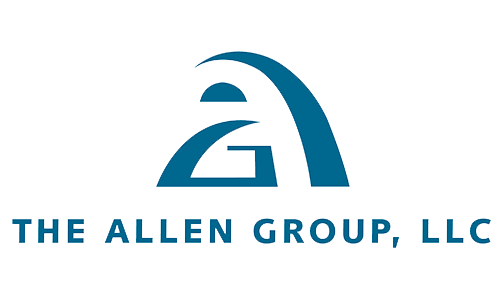



|
Consultants | ||||||||||||||||||||||||||||||||||||||||||||||||||||||||||||||||||||||||||||||||||||||||||||||||||||||||||||||||||||||||||||||||||||||||||||||||||||||||||||||||||||||||||||||||||||||||||||||||||||||||||||||||||||||||||||||||||||||||||||||||||||||||||||||||||||||||||||||||||||||||||||||||||||||||||||||||||||||||||||||||||||||||||||||||||||||||||||||||||||||||||||||||||||||||||||||||||||||||||||||||||||||||||||||||||||||||||||||||||||||||||||||||||||||||||||||||||||||||||||||||||||||||||||||||||||||||||||||||||||||||||||||||||||||||||||||||||||||||||||||||||||||||||||||||||||||||||||||||||||||||||||||||||||||||||||||||||||||||||||||||||||||||||||||||||||||||||||||||||||||||||||||||||||||||||||||||||||||||||||||||||||||||||||||||||||||||||||||||||||||||||||||||||||||||||||||||||||||||||||||||||||||||||||||||||||||||||||||||||||||||||||||||||||||||||||||||||||||||||||||||||||||||||||||||||||||||||||||||||||||||||||||||||||||||||||||||||||||||||||||||||||||||||||||||||||||||||||||||||||||
Visit the full Potrero Yard Modernization Project website for more information.